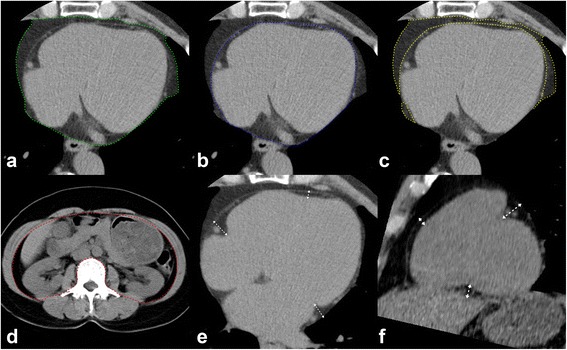Fig. 1.

Quantification of different abdominal and cardiac fat deposits by CT with a threshold of −200 to −50 HU on a 3-dimensional workstation. a Measurement of total pericardial fat volume by manual tracing (green boundary) of the area of the pericardial fat from the left main pulmonary artery level to the left ventricular apex. b Measurement of total volume of EAT was performed on axial images by manual tracing (blue boundary) of the parietal pericardium from the left main pulmonary artery level to the left ventricular apex. c Total volume of PAT (yellow boundary) = total pericardial fat volume (PAT + EAT) – total EAT volume. d Measurement of total volume of AVAT was performed on axial images by manual tracing (red boundary) of the parietal peritoneum from L2 to L5 levels. e Regional EAT thickness was assessed as the distance from myocardium in the orthogonal direction to visceral epicardium on the horizontal long-axis plane at the left AVG, right AVG, and anterior IVG. f On the parasternal short-axis plane, regional EAT thickness was measured at superior IVG, inferior IVG, and right ventricular (RV) free wall. Double-headed arrows indicate the measurements of the EAT thickness. HU = Hounsfield units; EAT = epicardial adipose tissue; PAT = paracardial adipose tissue; AVAT = abdominal visceral adipose tissue; AVG = atrioventricular groove; IVG = interventricular groove; RV = right ventricle
